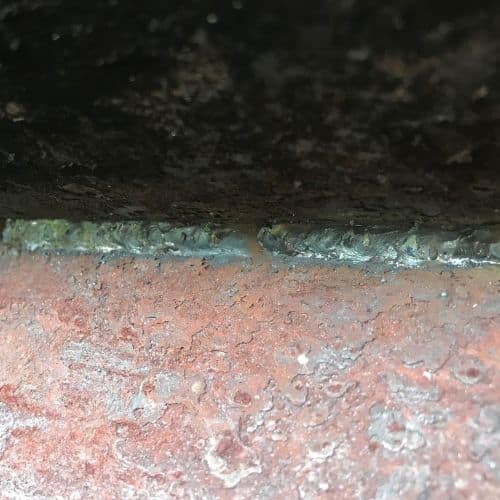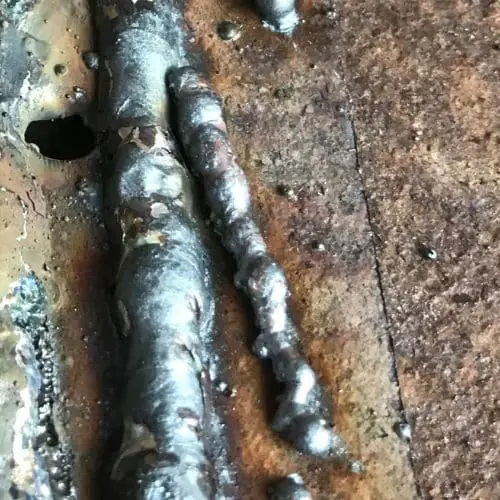Welding has many positions to work in, but a nice trick to create a stronger weld is to marry metal uphill in the vertical position. MIG welding downhill works best for thin metals and joints that do not have to face a lot of pressure and are not used in heavy-duty equipment. When you need to weld thicker metals and joints, MIG welding downhill is not a good option. It is not going to produce a strong weld. And so, you need to shift to MIG welding uphill. It is really challenging to weld uphill because it is difficult to control the puddle, but it is the best way to help you strengthen up that seam.
To answer your question directly, how strong a MIG weld is, it is stronger than the parent metals that are welded, the tensile strength of the filler metal minimum requirement is 70,000 PSI, which is A LOT
However, the weld can be strong but it does not mean that the base metals are bonded correctly and that they can stand such a high pressure before breaking. A real strength of the bond is determined by a lot of different factors like:
- Porosity
- Penetration
- Shape of the bead
- Stick-out of the filler
- The nature of the base metal or how clean it was prior to welding
How to make a stronger MIG weld?
Contents

If you are a beginner, you need to learn how to produce a stronger MIG weld. Using different methods, you can make your MIG weld stronger. Here are some important things to remember besides practicing in order to produce a stronger MIG weld:
Remove impurities
Impurities and porosity are present on the metal mostly if it is not clean. These impurities weaken the weld. You need to prepare your metal to remove all the impurities as GMAW welding is a really sensitive method to weld contaminated metals. Therefore, make sure you have sanded, wiped, and cleaned your metal so that the porosity will be minimal. (read more about porosity here)
Practice and test your welds
Before going for more constructional and important welds, you need to know if the techniques and setting you are using are good enough. Make a practice weld and apply some stress on it, use your imagination if you don’t have equipment for proper testing. You can use a hammer or drive your truck on a welded piece.
If you weld cracks under pressure, you need to change your technique and maybe setting.
Run two passes along the weld joint
Taking an extra pass along the welding joint helps a lot. It is a good idea to run two passes as it gives extra fusion between both sides. Also, a second weld is comparatively stronger than the first one as metal is already pre-heated.
So, if your joint is narrow and you want to have a stronger weld, a bit of pre-heating is great. However, make sure it doesn’t get too hot.
The wire should be short
A long wire stick out causes an erratic arc. While you are doing MIG welding uphill, it requires keeping stick out for MIG welding on the shorter side. It will give better control, penetration and stronger welds.
Equally important is the quality of the filler wire you are using. This is the one I am using, and it is available on Amazon at a fair price.
Modify settings as you work
When you start welding, your setting should be for thinner metals to avoid burn through. As you work, you can modify the settings to make it perfect, I know it sounds complicated but after a while, you will know which set to pick and fine-tune. Using enough power for good fusion is important. However, power and wire feed speed must not be so high that melted metal pours down as you weld.

MIG welding strength test
Now if you are done with MIG welding but are not confident enough of how strong your weld is, you need to have a strength test.
There are several methods to test the strength of your weld. While there are a number of physical tests, some basic visual inspection methods also help greatly.
Visual inspection
After you are done welding, you can check your weld against codes and standards. The first thing you need to do is to check size of the metal with gauges and prints. You can see if the finish and contour is fine enough. Check if the weld has impurities.
Moreover, look for overlap and undercut to confirm the strength of weld. Also, the spatter should be at acceptable levels.
When it comes to physical testing of MIG welding strength, there are a lot of tests such as Hydrostatic Test, Magnetic Particle Test, X-Ray Testing, Gammy Ray Testing, and Fluorescent Penetrant Test (also known as Dye Test).
X-Ray Testing
This is the most common type of MIG welding strength test. It is a radiographic physical weld testing method. It helps in identifying the presence and nature of internal defects such as cracks, blowholes, and zones, etc. if any!
After you run an X-ray test, the defects appear as black spots and bands.
Dye Test
Dye Penetrant Test is used to locate cracks, leaks, and pores in welding on solid material surfaces like aluminum and steel welds. Through exceptional penetration qualities of water, you can check if your weld is strong enough or not.
This testing is good for ferrous and non-ferrous materials. Also, it is cost-effective and requires minimal training.
What is the strongest type of weld?
As there are different types of weld such as MIG welding, TIG welding, Arc welding, and Stick welding, let’s compare them to know which one is the strongest.
MIG Welding
MIG welding is the most common type. It is very simple to learn for a beginner. It is strong for both thin and thick materials.
However, you need to know:
- It is not strong if the material is too thin or too thick
- It doesn’t work for cast iron
- It is too powerful to handle thin aluminum
- It doesn’t provide strong weld in windy or wet conditions
TIG Welding
TIG welding uses helium or argon gas and has stronger welds than MIG. And so, it is used for aesthetically pleasing welds. It is good for automotive and sculptures.
Stick Welding
Stick welding produces exceptionally strong welds. It works best for thick metals, heavy repairs, construction, cast iron, and has cheaper equipment. Also, it is capable of giving strong welds in even bad weather.
Overall, stick welding is the strongest type of weld comparative to others.
Conclusion
Each welding style has its limitations. If one weld works best for a particular material, the other doesn’t. Talking about MIG welding, it is strong enough if all the important aspects are taken care of 70000 PSi is a lot of strength, however, if you don’t do your job carefully it can get dangerous.
